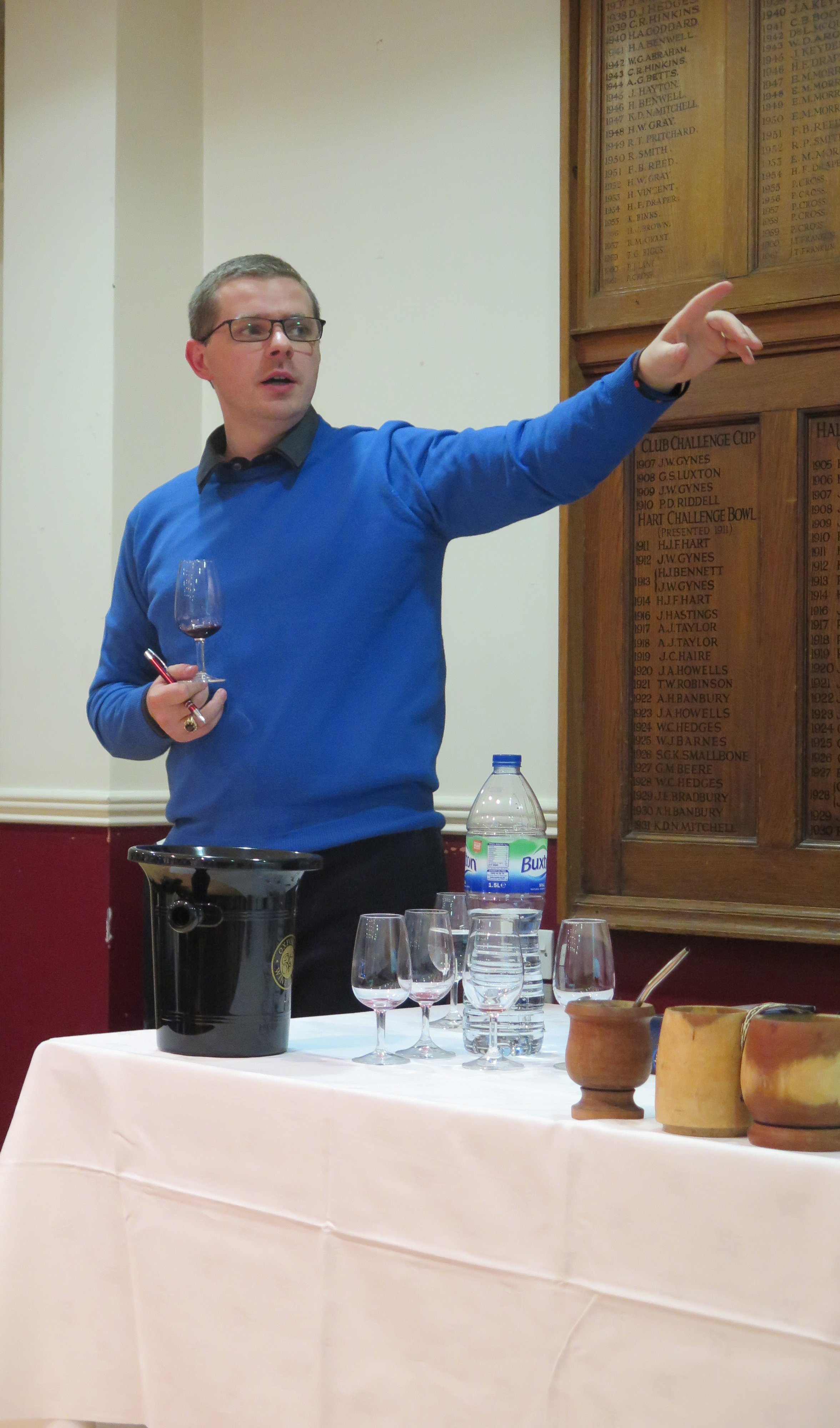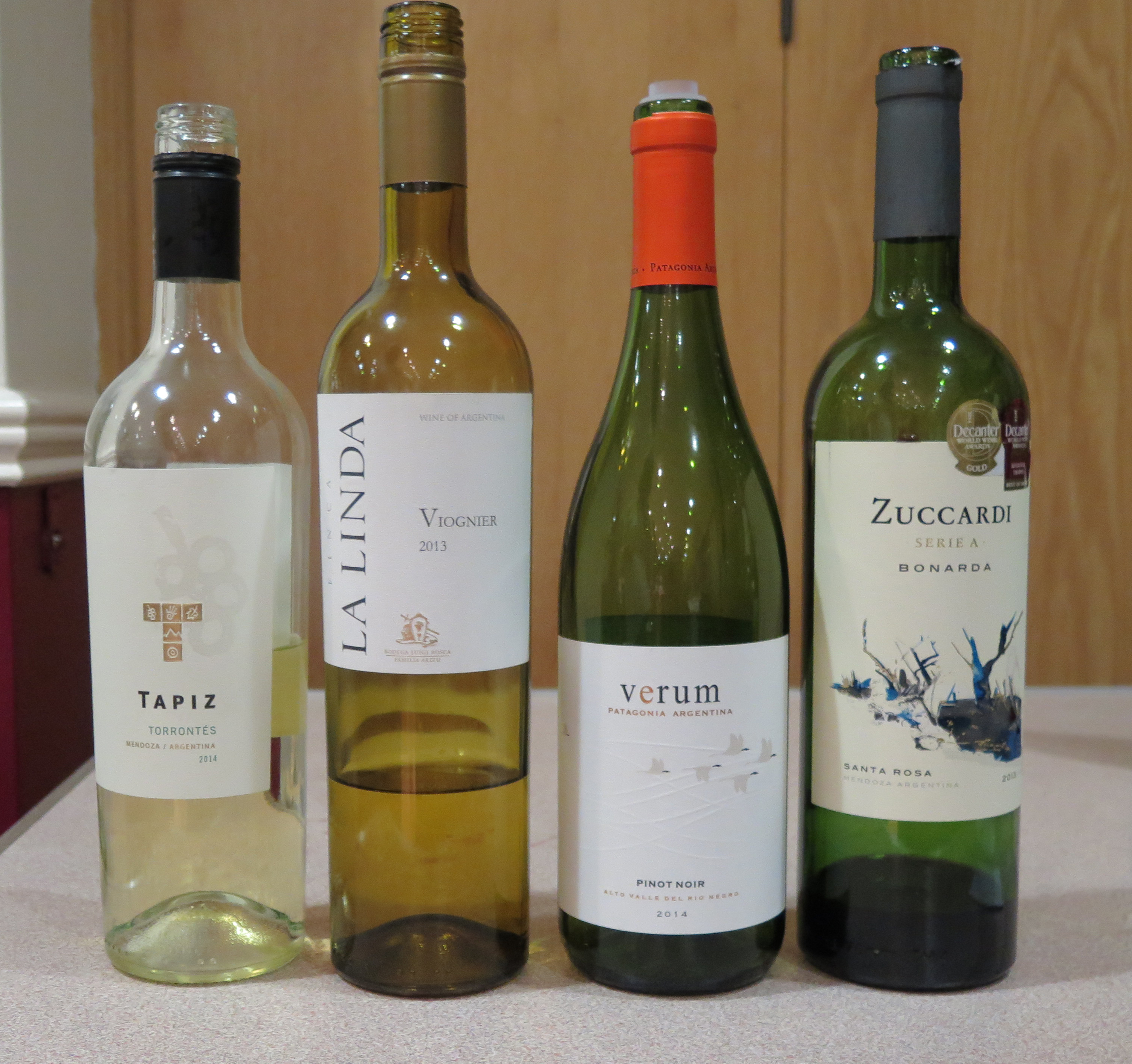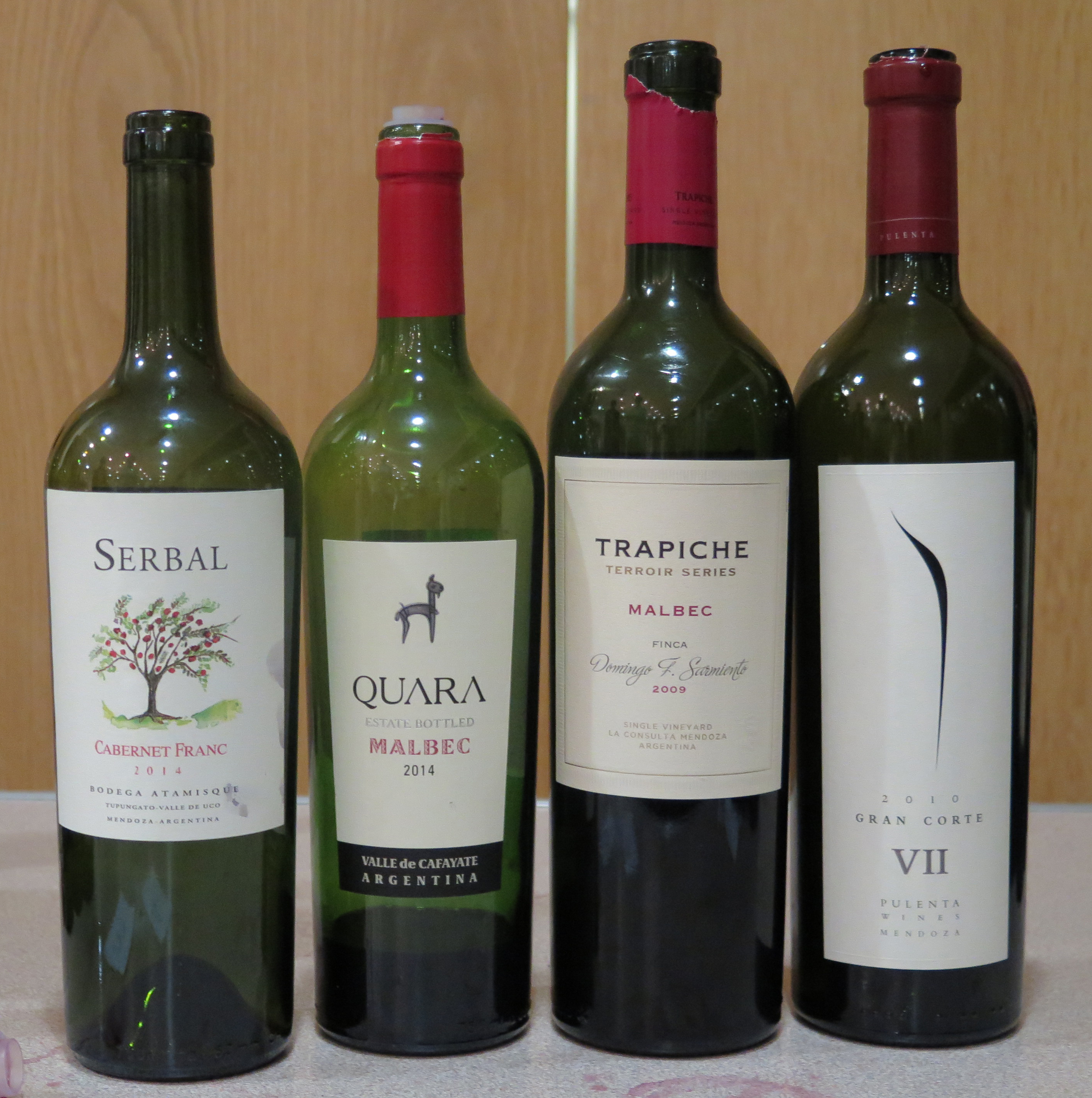
The Club’s October tasting featured Lee Isaacs presenting wines of a country that he is passionate about. Married to an Argentinian (he says that leaves him little choice about his taste for wines of Argentine), he visits the country regularly and has explored the wine regions from Salta in the north to Patagonia in the south.
The Argentine wine industry goes back to the Conquistadores (although it’s the Italians who’ve had most influence on the wines in the last hundred years). The first commercial vineyard was established in 1557 and its purpose (in a nutshell) seems to have been to provide wine to keep the native populations too sozzled to protest at the Spanish occupation. That focus on quasi-industrial production has left its mark on Argentinian wines which have only started to explore variety and terroir in any serious way in the last decade. Fifty years ago the annual consumption was 90 litres per capita (Britain at the same point was drinking 3 litres per head).
In the last decade, wine merchants and consumers in the US and UK in particular have realised the potential of Argentina and its natural wine assets. Wine can be made up to around 6500 metres altitude and this abundant high ground gives great diurnal variation. Andes meltwater provides the resource for irrigation and there’s consistent sunshine in the growing season.
We started the tasting with two white wines: a 2014 Torrontes from Fincas Patagonicas and a 2014 Viognier from the Bodega Leoncio Arizu. Argentina is not generally known for its whites (though most Club members knew them) and they make up only around 10% of exports. The Torrontes, said Lee, was not the same as the Spanish Torrontes – indeed a different grape, a blend of Mission (brought by the Spaniards for communion wine) and Muscat of Alexandria. Knowing that cepage the floral, grapey aroma with a touch of citrus was no surprise. This is a grape with high levels of pectin which demand a decent maceration to get the flavour out. Stylistically this was an expression of the Salta style with high acidity and a crisp palate rather than the warmer style from the lower altitude Mendoza vineyards. Like the Viognier which followed it had relatively high alcohol at 13.5% which gave a slightly unbalanced finish.
The Viognier was from the ‘La Linda’ finca; Linda being (according to company myth) the name of the stripper who  fell into the proprietor’s lap one afternoon and shortly thereafter became his wife. Luigi Bosca, the current owner, is now tailoring his wines to the US market and the rich taste and texture came through the initially rather oaked nose. The challenge with Viognier is always how to keep the acidity (though the Americans tend to prefer the lower acid versions) and to ensure this, Bosca sources grapes from a number of different areas. A wine to drink with brandy snaps and roast pineapple was the verdict.
fell into the proprietor’s lap one afternoon and shortly thereafter became his wife. Luigi Bosca, the current owner, is now tailoring his wines to the US market and the rich taste and texture came through the initially rather oaked nose. The challenge with Viognier is always how to keep the acidity (though the Americans tend to prefer the lower acid versions) and to ensure this, Bosca sources grapes from a number of different areas. A wine to drink with brandy snaps and roast pineapple was the verdict.
Moving on to the red wines, we started with the 2014 Verum Pinot Noir but not before Lee had given us a concisely impressive run-down of the modern challenges facing Argentinian wineries. The financial collapse of the country under Carlos Menem led to the railways – a vital link in this hugely extended country – being torn up for the sake of their steel. High levels of inflation make financing difficult and the lack of foreign currency reserves has led to frequent bottle shortages. The lack of a railway link in particular has made Patagonia increasingly inaccessible for the casual visitor and meant that it has taken time to establish the areas’ wineries. Much lower than the heartland Mendoza region at around 200 metres but with temperatures in far south down at 27 degrees and almost constant wind, the grapes need more protection. Lee showed photographs of the poplar windbreaks and the ancient wines that contribute to making Patagonian Pinot Noir a future star (his guidance was to avoid Pinot Noir from elsewhere in Argentina as too jammy and rather soft). This example was a light cherry red, with savoury notes on the nose and bright rich fruit on the palate. Expressive and vivid this would be a fine food wine, quite unlike the Malbec fruit bombs that dominated the Mendoza area for so many years.
 Indeed Lee reckons that Mendoza Malbec, the signature Argentine grape for so many years, may be in danger of becoming a millstone. Too many people are ‘Malbecced out’. Some commentators reckon that Bonarda could be the next ‘signature grape’ for Argentina, and we tasted a 2013 version from the Familia Zuccardi. Classic garnet core with a narrow rim and a nose of plums, white pepper and some sweet oak. Medium plus body and balancing acidity with a blend of sweet plum and savoury flavours. This led into a discussion of the different Mendozan regions: the Uco Valley (home of the Zuccardi family) is high and breezy giving better fruit definition; Maipu is lower and tends to baked fruit and entry level wines; Luzan de Cujo is in between, lower than the Uco but benefiting from limestone terroir. Once again the Bonarda name is a rather ‘false friend’. This is not the Bonarda of Piemonte but a versatile grape (for some the ‘Red Chardonnay’) that responds well to oak and a range of treatments, particularly when the yield is held down.
Indeed Lee reckons that Mendoza Malbec, the signature Argentine grape for so many years, may be in danger of becoming a millstone. Too many people are ‘Malbecced out’. Some commentators reckon that Bonarda could be the next ‘signature grape’ for Argentina, and we tasted a 2013 version from the Familia Zuccardi. Classic garnet core with a narrow rim and a nose of plums, white pepper and some sweet oak. Medium plus body and balancing acidity with a blend of sweet plum and savoury flavours. This led into a discussion of the different Mendozan regions: the Uco Valley (home of the Zuccardi family) is high and breezy giving better fruit definition; Maipu is lower and tends to baked fruit and entry level wines; Luzan de Cujo is in between, lower than the Uco but benefiting from limestone terroir. Once again the Bonarda name is a rather ‘false friend’. This is not the Bonarda of Piemonte but a versatile grape (for some the ‘Red Chardonnay’) that responds well to oak and a range of treatments, particularly when the yield is held down.
The fifth wine was another one from the Uco Valley, a 2014 Serbal Cabernet Franc. Not yet known in the UK for either Cabernet Franc or Petit Verdot, the consensus is that both these grapes have a lot of potential. They are easier to ripen in Argentina and give well-coloured and well-rounded wines that have softer tannins than the French versions. This Serbal wine had an interesting, slightly spicy nose (helped by French oak treatment) with fairly rich red fruit in the mouth. A pleasing wine.
This was followed by an entry-level Bodega Quara Malbec from the Salta. The nose featured mulberry and a touch of pepper with a palate that was dry, of fresh acidity and ripe tannins that balanced the relatively high alcohol. Cool maceration keeps the wine soft and fresh and preserves the black fruit flavours.
Then came two wines served blind to test us a little. The first was a high quality Malbec from Trapiche Sarmiento at just under £33. Trapiche are a major producer (the fifth biggest wine producer in Argentina) but this wine is very far from industrial. Each year the wines of 50 of their top growers are blind tasted and the four top wines are bottled as single vineyard products. In 13 years none of these wines has ever scored less than 92 Parker points and this example showed some of Parkerian notes: rich and concentrated with fine blackcurrant fruit and 15% alcohol. This was a wine of the 2009 vintage and we were undeniably drinking it too young (‘infanticide’ said Lee). From producers in other markets this would have been a £60-£80 bottle; here it’s retailed at £32.99 (and Lee had negotiated a discount down to £28.04 from the Oxford Wine Company).
The last wine of the evening was a Pulenta Gran Corte of 2002. Buy a (new) Ferrari in the Argentine and you get a case of this in the boot! The blend is dominated by Malbec and Cabernet Sauvignon with added spice from Tannat, Petit Verdot and Cabernet Franc. Less obvious oak on the nose than the Trapiche wine this was more black cherry on the nose with plenty of fresh acidity and smooth tannins (just a tingle of grittiness) leading to a long and complex finish. An excellent wine at £26.95.
That closed the Argentine tasting, though members then had the chance to sample some artisan cheeses selected by Peter Coggins and served with a range of Ports and Madeiras from the Cambridge Wine Company.
The Tasting of Ports and Madeira’s comprised of a selection made from a much larger trade tasting by Cambridge Wine Merchants earlier in the day. The stars from this selection were as follows.
The Henriques and Henriques 3 yo Dry Madeira was a delight, showing the fruit at its best. The wines of Madeira are great value. From the same stable Henriques and Henriques 10 yo Malvasia (aka Malmsey) provided a stunning counterpoint to the above providing the opportunity of comparing two very contrasting styles.
The wine world has many differing style of Muscatel. The Bacalhoa Moscatel de Setubal provided a very interesting stylistic variation. Lighter in style with a delightful rosé colour this wine was much lighter in style but with the typical characteristic of marmalade and caramel. Very good value.
As with the wines from Madeira, the selection of Ports demonstrated the incredible value of these wines whilst demonstrating the craft and skill in making them. The House of Graham, showed very well, with two wines showing particularly well. The Graham’s Crusted Port Bottled 2007 was rich forward, with powerful finish, a fabulous wine drinking superbly well just now. The Graham’s 10 yo Tawny Port differing in style but equally delicious, ready to drink and perfect for Christmas.
Finally, Fonseca Guirmaraens 1998 Vintage Port demonstrated that consistency is the byword at Fonseca. This House produces that deliver style, elegance, weight and the epitome of all that a vintage Port should be.
GH: 25/10/15